Welcome back to Week 13 in my weekly reports analyzing the Covid-19 pandemic and its effects on the country, higher education and study abroad. I have been following this pandemic since the first outbreak in Wuhan in January, during which time I was in China. As I have reported previously on this blog, I was in Beijing studying abroad when the coronavirus outbreak prompted our program to abruptly suspend operations and students had to quickly repatriate to the United States. Since the beginning of the outbreak, I have spoken to a number of media outlets to discuss the situation and my reporting. For those of you reading this on my blog, Off the Silk Road, I have also launched a newsletter, where these reports can be sent directly to your email each week. Click here to subscribe.
Last week, I looked at surges in certain hotspots across the country as some colleges have decided to roll back reopening plans. This week, we will examine some states rolling back reopening plans, colleges moving instruction online and new warnings around the conversation of reopening K-12 schools.
There’s a lot of material to go through (as per usual), so let’s get straight to it.
A national look
As the United States confirmed its highest single-day case count on Friday, 63,900, we are left wondering, what did we learn in March and April? “We’re living in a perfect storm,” Dr. Anthony Fauci said to the Financial Times on Friday. “We are in free fall,” said Dr. Rochelle Walensky, chief of infectious diseases at Massachusetts General Hospital. Only four states nationwide are currently showing a decrease in cases compared to last week: New Hampshire, Maine, Connecticut and New Jersey. Cases are up, hospitalizations are up and deaths are up, with 854 people nationwide succumbing to the virus on Friday. The test positivity rate in Miami was a staggering 33.5% on Friday; the WHO recommends a two-week test positivity rate of under 5% to consider easing restrictions. The president has not attended a task force meeting since April as his accomplices continue to push hydroxychloroquine, an unproven drug to treat Covid-19 that has had adverse effects, including an increased risk of death. In many places, contact tracing has failed — a CNN investigation in Florida found that out of 27 interviewees who all tested positive, only five received a call from a contact tracer. (And Disney World is reopening!) As we still continue to see the possible effects of July 4 on viral transmission, I am seriously concerned about the state of the nation.
In a way, this stage of the pandemic is much more dangerous than what we experienced in March and April. During that time, there was only one major hotspot — New York. Now, outbreaks continue to surge in many hotspots around the country as Quest Diagnostics, one of the largest private labs, has increased their estimated wait time for results from 3-5 days to 4-6 days. Atlanta mayor Keisha Lance Bottoms, who has tested positive for Covid-19, waited 8 days for her results. There are still lines for testing. Without fast results from testing, it is impossible to effectively isolate those who test positive and stop the spread. Shortages of personal protective equipment (PPE) have continued as Vice President Mike Pence has encouraged healthcare workers to continue reusing N95 masks. Have we learned anything? Did we change anything?
But wait — the White House has a strategy! As The Washington Post reports, “[The White House is] of the belief that people will get over it or if we stop highlighting it, the base will move on and the public will learn to accept 50,000 to 100,000 new cases a day,’ said a former administration official in touch with the campaign.” Live with it? We cannot become numb to the adverse effects this virus brings not only to our most vulnerable population, but continues to spread like wildfire across younger generations. Denying, lying and dividing is not a strategy as we surpass 3 million confirmed cases. “How is it difficult for humans to unite and fight a common enemy that is killing people indiscriminately?” Director General of the World Health Organization Dr. Tedros Adhanom Ghebreyesus asked. Hospitals need more staff and equipment as Arizona holds a 27% test positivity rate. The IHME has projected 208,255 deaths by November 1, a projection that seems to keep rising.
Let’s look at Vermont, a state that has been lauded for its containment strategies. This graph, made by my colleague Erin Petenko at VTDigger, shows a phased reopening approach that has resulted in very low viral growth.
Vermont’s contact tracing operation is aggressive. 97% of its positive cases are interviewed by contact tracers within 48 hours of their test result. “Timely interviews have been critical in interrupting disease transmission,” Health Commissioner Dr. Mark Levine said. Similar to Vermont, Rhode Island Governor Gina Raimondo has been praised for her strategy of using private pharmacies as test sites.
As cases turn into clusters which turn into outbreaks, Trump’s America First strategy has turned into America Last. As the U.S. has formally withdrawn from the World Health Organization, I think it’s important to say that anything coming out of the president’s mouth related to the pandemic is either nonsensical, false or dangerous. Sometimes it’s a combination of all three. Even the CDC has begun to show signs of caving to political pressure, pledging to issue new guidance for reopening schools (and then walking back on this promise) after the president said they were too “tough and expensive.” America is not flattening the curve, it is fattening the curve. In an interview, Trump said that we are in “a good place,” which begs the question:
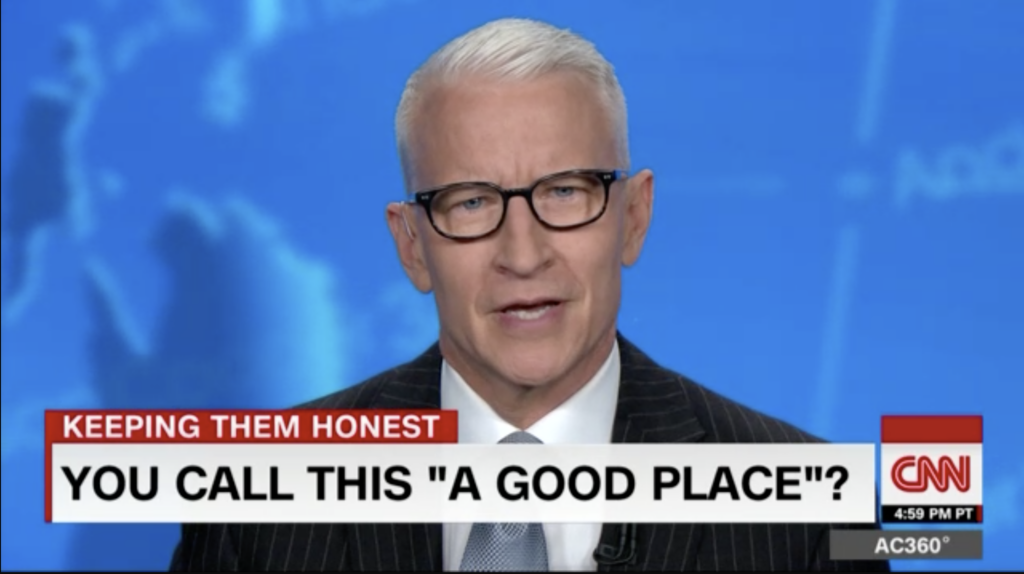
There has been much discussion this week on the decision to reopen K-12 schools in the fall, as Trump has threatened to put pressure on governors and even cut funding for public schools if they do not fully reopen. It was never a question of if schools should reopen, but how. Schools need funding for testing and supplies. Dr. Leana Wen argues that in order to reopen schools, we need to suppress the level of infection in the community. So America faces a choice: bars now and no schools, or no bars and schools in the fall. Nashville has already delayed the start of its schools, which were due to start in just over a month. While the American Academy of Pediatrics has argued that schools must reopen, it has clarified that “we must pursue re-opening in a way that is safe for all students, teachers and staff.” We also still don’t know how age affects transmissibility. Previous studies showed that children have the same viral load as adults. Maybe they’re less likely to be infected. Maybe kids have not transmitted much so far since they have been home since March. We need evidence-based decisions, not political pressure and orders.
Let’s take a moment to address Trump’s Tulsa rally on June 20, which has seen a surge in cases in the weeks after. This is no surprise. The man can’t even fill an arena and he still spreads the virus.
I performed a brief analysis at the beginning of the week investigating viral spread across the country and density. Is there a correlation between Covid-19 cases and county density? Does the disease spread more easily in cities? On a national level, yes. As seen on this map and scatterplot, there’s a reasonably high correlation (r=0.77) between population density and confirmed cases.
However, when examining New York City on a ZIP code level, there appears to be a very weak correlation (r=0.01). Manhattan, the densest borough, has among the lowest infection rate. Are there other factors at play? Maybe minority populations play a role.
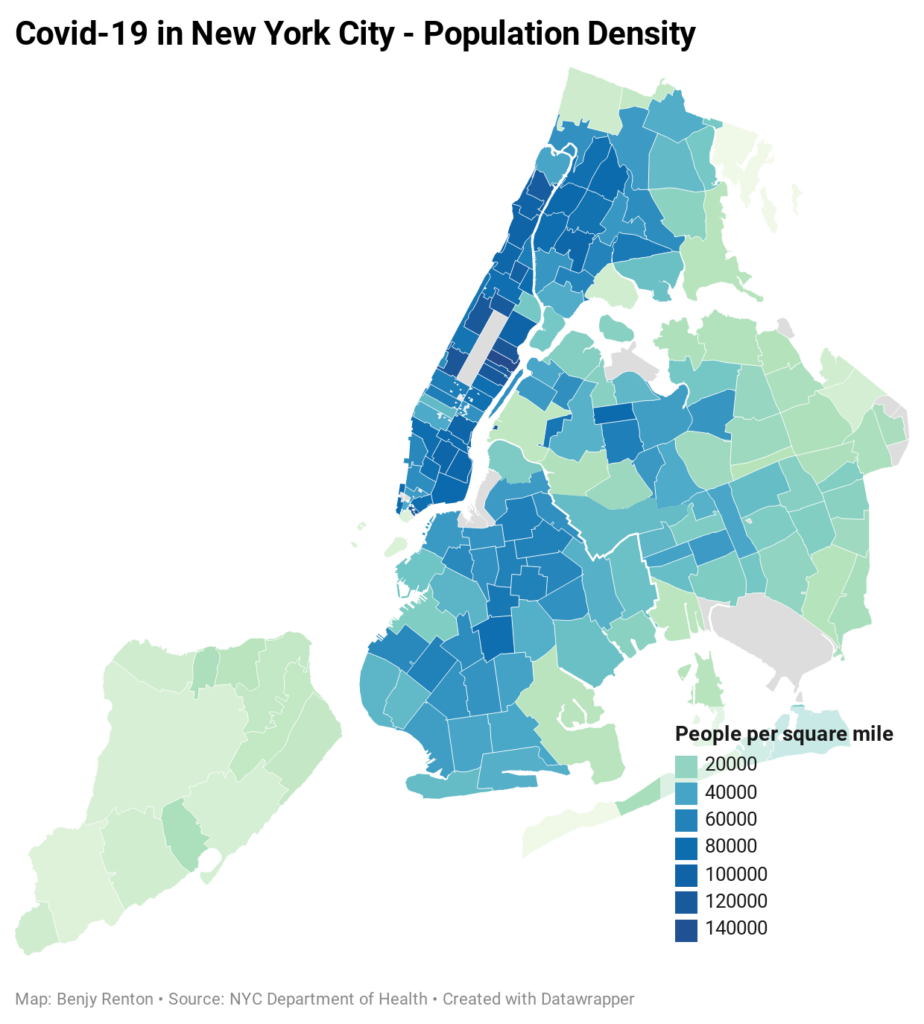
As usual, we have seen more studies published and new information now available to help us better understand Covid-19. Let’s take a look at some of the highlights:
- Immigration and Customs Enforcement (ICE) contributed to the global spread of the pandemic, deporting thousands of sick people back to their home countries.
- The WHO has acknowledged that the coronavirus can be possibly transmitted through aerosols.
- A study from Spain showed seroprevalence (the percentage of those who developed antibodies) at around 5%, with 41% of cases reporting loss of smell.
- This study showed that test sensitivity is secondary to frequency and rapid return of results.
- Contact tracers in South Korea show how effective the government worked to control the spread of outbreaks in nightclubs.
- A Florida father and sons were arrested for selling a potentially deadly bleach product billed as a miracle cure for Covid-19 through a fake church.
- Summer camps across the country have seen outbreaks, as well as the Air Force Academy.
- A new study helps us distinguish presymptomatic and asymptomatic transmission. Assuming 17.9% of cases are asymptomatic, the team found that presymptomatic people would account for 48% of transmission, and asymptomatic people would account for 3.4% of transmission.
- According to one study, prisons have a 5.5 times higher mortality rate than the general population.
- A CDC study of 16,233 cases in meatpacking plants showed that 87% were connected to a racial or ethnic minority.
- A study of previous patients in Italy found that only 13% of cases were symptom-free two months later and 44% indicated that their quality of life decreased.
- This new network analysis shows how the pandemic spread across the U.S.
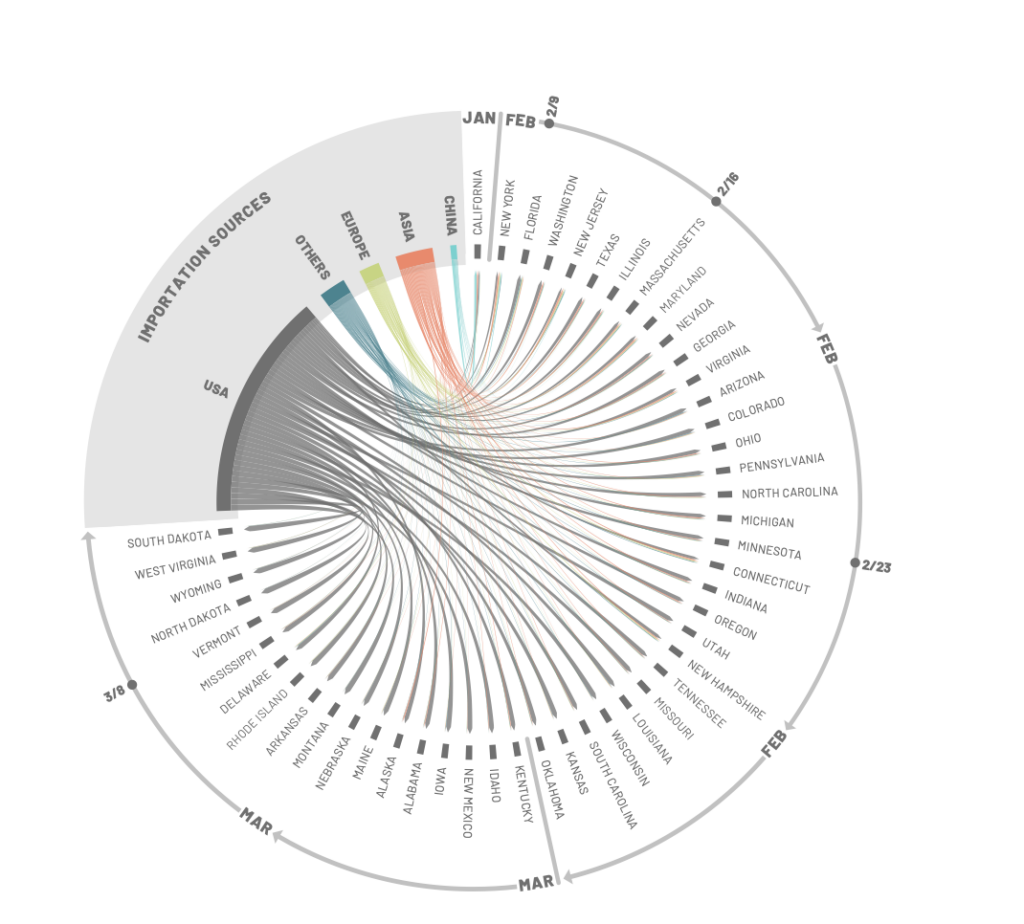
Around the world, we’ve also seen new developments:
- Brazil’s president has tested positive for the coronavirus even as he denied its gravity and is currently taking hydroxychloroquine.
- Australia has locked down a region around Melbourne after 921 new cases in 7 days.
- Japan has seen relative success with beating the virus through “cluster busters.”
- Israel is experiencing a “second wave.”
- Hong Kong has closed schools after 38 new cases emerged.
- After 137 days, the ICU in Bergamo, Italy’s major hospital has cleared its last coronavirus patient.
- Beijing has contained its recent outbreak through aggressive testing. In the past 25 days, the city has tested 11 million people, 51% of its population. In the same time period, the entire United States has tested 14 million people, 4.4% of its population. Beijing has conducted 51,068 tests per 100,000 people, compared to the U.S.’ 4,436.
- Sweden tried herd immunity. It didn’t work.
Across the country, we have started to see changes to Americans’ daily behaviors as the economy begins to stagnate again, according to this chart.
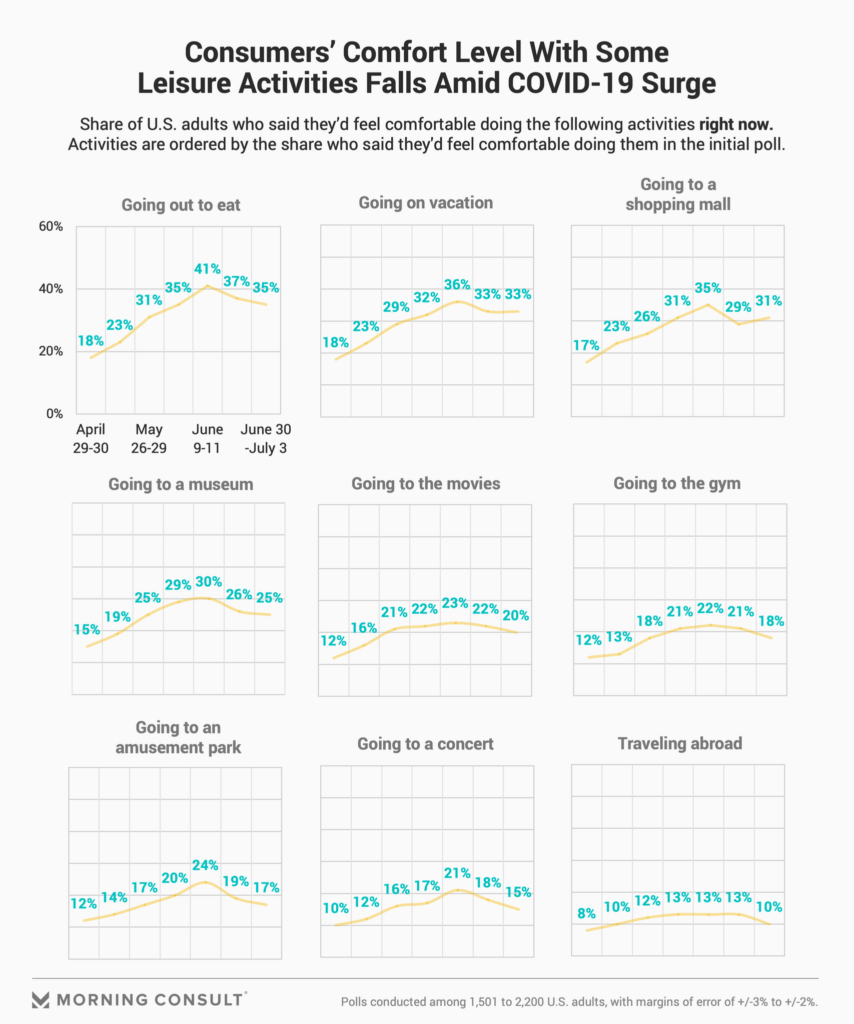
So how is reopening going? Pretty poorly, as Atlanta has rolled back into a stay at home order.
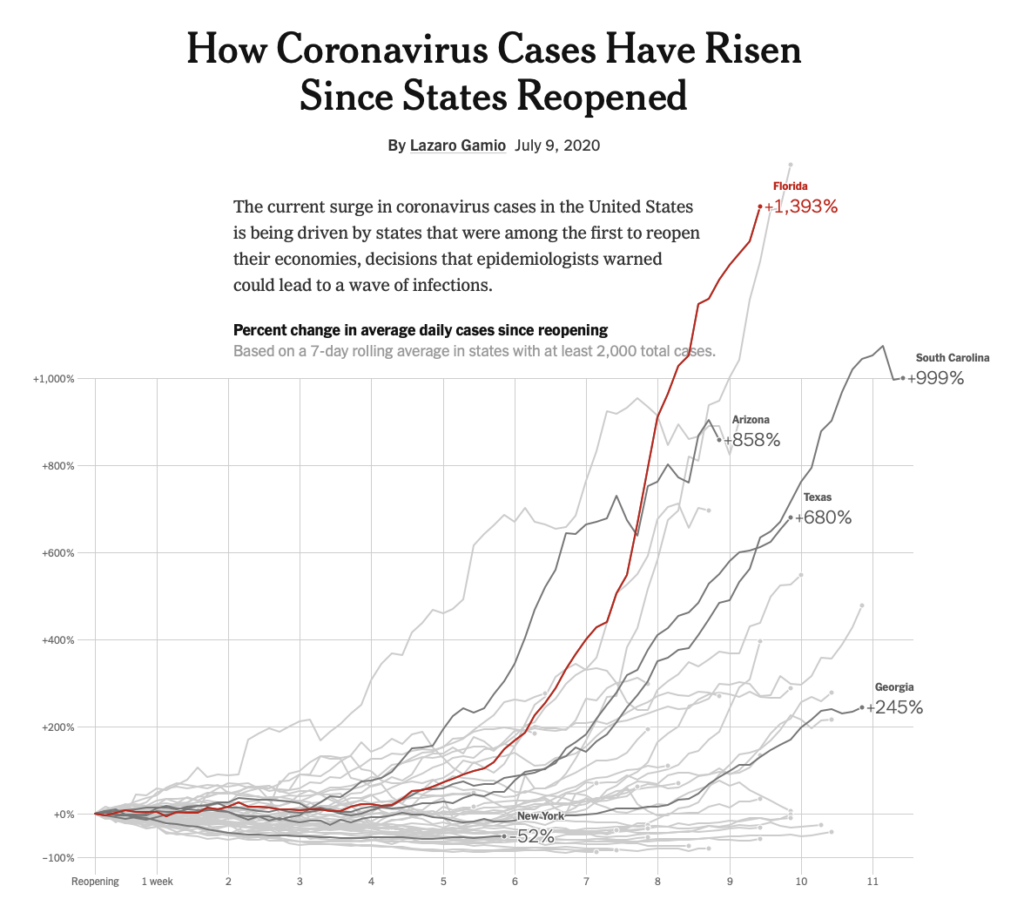
Just look at all these hotspots.
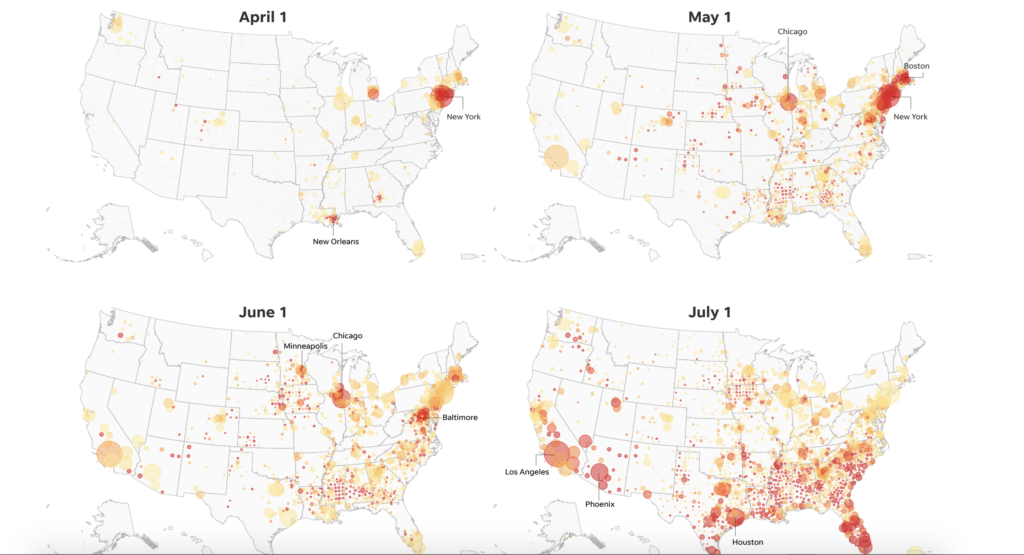
So how do we get out of here? We know a national strategy is not coming. Trump has complained in private that the pandemic is hurting him as morgue trucks have arrived in Arizona. There are three major failures we see currently:
- Failure of leadership
- Failure of a public health service (the CDC)
- Failure to unite the population against a common cause
Want to know why we receive different case counts each day depending on what TV channel you watch? Because we don’t have a competent CDC that keeps track of national data on a real-time basis. There’s a major erosion of the truth in our society and we are seeing the cost manifested in human lives. Virus fatigue has set in and some states have discovered we cannot test our way out of this. No one wants to return to stay-at-home orders, but for some states that may be the only option. Even Bill Nye the Science Guy is telling us to wear a mask.
What are three metrics we must continue to watch in each area of the country?
- The test positivity rate
- The number of hospitalizations
- The number of ICU admissions with Covid-19
I’d like to finish our national tour with a note towards a vaccine. In order to most efficiently distribute a vaccine among the population when it is approved, we must be making social and behavioral changes now, according to Johns Hopkins researchers. My colleagues at the CC Covid-19 Reporting Project created this graphic to help us track the status of vaccines as they are being developed.
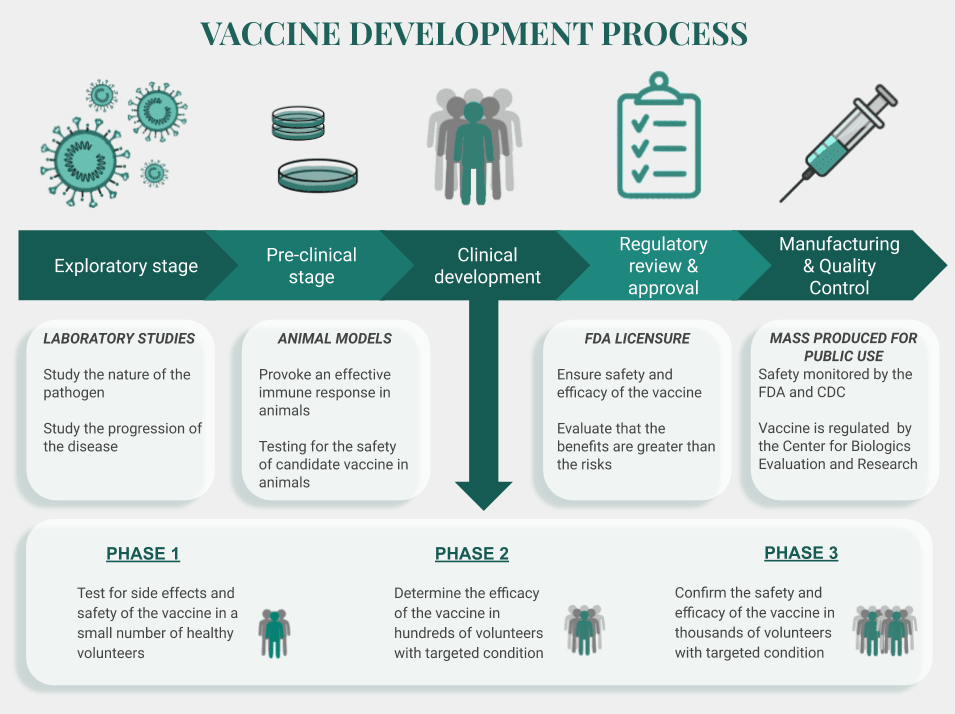
Having laid down the groundwork on the national scene, let’s take a look at the latest developments in higher ed.
Higher education
We’re approaching the middle of July, and for some institutions the return to school is a mere few weeks away. For many schools, this could mean a reconsideration of their plans to bring all students back. A report from the American Enterprise Institute on the future of higher ed reads: “Expect more institutions to revisit their reopening plans and enact contingency plans for an online fall.” For some institutions, this is already a reality. As reported by my colleagues at the Claremont Colleges, Pomona College and Scripps College have announced they will close their campus and offer online-only courses for the fall. As Andy Thomason at The Chronicle of Higher Education notes, this is a marked departure from Pomona’s previous statements.
- Pomona, May 7: “…our hope and our expectation for fall is to be able to resume in-person classes and restore the on-campus residential community…”
- July 8: “In this unfolding emergency, we will not be able to bring students back to campus in the fall.”
Pomona and Scripps join a growing list of colleges that have “flipped” — reversed their reopening plans. We will be keeping track of them on this map.
I call the determination or likelihood for a school to flip its “flip elasticity.” A college can be “inelastic” — less likely to flip to online for the fall — or “elastic.” In the coming weeks, this will be a good framework from which we can analyze colleges’ changing plans.
It would be remiss of me not to discuss a major development in U.S. student immigration policy this week that could have massive impacts on the world of higher ed. This week, Immigration and Customs Enforcement issued new guidelines for student visas for international students. While we are still unsure as to the final policy, what we currently know is that this is a dangerous move. If a college is completely online, its international students must stay in their home country and take classes. If they are still in the U.S, they must transfer (which is impossible at this point) or leave the country. If a college is holding classes in person, international students must return to the U.S. (in the middle of a pandemic) and take classes on campus. This policy could also push infected people to other countries that may have done a better job at controlling the virus. If the college is some form of “hybrid,” schools need to confirm to ICE that the student is taking the minimum number of courses to make progress in their degree and must take at least one class in person. This means that for students outside of the country, they must return to the U.S., even though the U.S. has closed its borders to some countries (including those from China) and flights and visas are hard to obtain. It is worth noting that an Institute of International Education (IIE) survey found that in May the vast majority of international students still remained in the U.S. If a college moves online at any point during the semester, its international students must leave the country within 10 days. We are still unclear if that means international students must leave when many colleges switch to online instruction in November.
In an interview with CNN’s Brianna Keilar, Acting United States Deputy Secretary of Homeland Security Ken Cuccinelli said that “This is now setting the rules for one semester, which we’ll finalize later this month that will, again, encourage schools to reopen.” This indicates that the goal of this policy is to pressure schools to reopen in person, using international students as political pawns. Despite the public health emergency, the Trump administration is using this misguided, dangerous and cruel policy to advance their hardline immigration agenda. International students create $31 billion in GDP and support 458,000 jobs. That is a fact. International students greatly benefit the American economy and this administration has failed to realize that.
There has been much discussion about this policy around many institutions, with colleges releasing statements pledging to protect their international students. It is important to note that we still do not know what the final policy will be, even though the deadline for schools to submit online-only plans to ICE is July 15. Professors at colleges and universities have offered to hold independent studies to count as courses so international students can remain in the U.S. One Harvard student has already been stopped at an airport in Belarus. A lawsuit has been filed by Harvard and MIT and many schools have joined, with over 57 signing amicus briefs. Members of Congress have also opposed the policy. “It’s so sad to see our education be used as a political tool by the government to force the country to reopen,” one international student at Bowdoin told The Bowdoin Orient. A federal judge in Boston has set a hearing for this coming Tuesday, stating that it may be possible that the court could block the order. “My gut on it is that the big-ticket item here is going to be a likelihood of success on the merits,” Judge Allison Burroughs, Middlebury Class of 1983, told The New York Times. This also comes at the same time Trump has threatened to cut universities’ tax-exempt status, tweeting that too many “are about Radical Left Indoctrination, not Education [his capitalization, not mine].” Just look at what Chinese students in the U.S., both undergraduate and graduate, are considering (this was a graphic translated into English from Chinese social media).
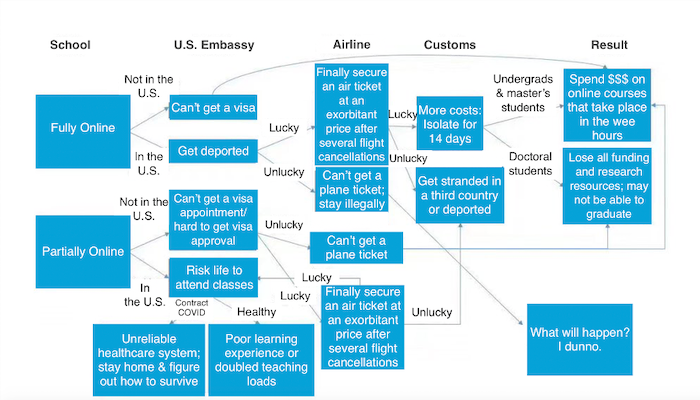
Let’s take a moment to discuss notable plans that we have seen from schools this week. Harvard University, that small college in Boston no one has heard of, announced this week that 40% of its undergraduates will return, as reported by my colleagues Juliet Isselbacher and Amanda Su. This will include its freshman class and others for whom remote learning at home is impossible. All classes will be conducted virtually for the academic year, with three possible residential options for the spring: worsened conditions (only students who must learn from campus), swapping out for seniors, and welcoming back multiple class cohorts. This decision will be made in December. Harvard’s decision could possibly set off a wave of others — as one higher ed professional notes, “When Harvard sneezes, other colleges catch cold.” Rutgers University, a large research university in New Jersey, plans to conduct the vast majority of classes virtually, with only approved populations on campus: international students, student athletes, graduate students and students with special circumstances. Princeton University will welcome first-years and juniors to campus for the fall semester and sophomores and seniors for the spring semester (as higher ed professor Kevin McClure notes, this situation is not ideal for sophomores dating juniors). Harvard and Princeton have also issued plans for a de-densified spring, indicating the return to “normal” will not happen anytime soon.
Brown University will open under a tri-semester model, as reported by my colleagues Kayla Guo, Henry Dawson and Li Goldstein. Students will enroll in two out of the three terms: Incoming first-years will be allowed to come to campus for the spring and summer semesters, while sophomores, juniors and seniors may return for the fall and spring. This “rotating” term structure is used for de-densification and has also been employed by Stanford University, among others. Colorado College has prepared to de-density housing, purchasing apartments miles way from campus and planning for a shuttle service. After significant backlash, the University of Georgia will make masks mandatory this fall. In contrast to Harvard, which will only bring freshman to campus, MIT will invite seniors only back to campus this fall. In one of the wackier demands in college reopening plans, Hobart and William Smith Colleges are requiring students to wash their masks and clothing once per week. Syracuse University is mandating that students show proof of a negative test before arriving on campus, which may be hard from students in communities where testing is not as accessible. The University of California, Berkeley’s plans are in jeopardy after 47 confirmed cases have been linked to frat parties. Bates College has said that “social relationships will flourish through ‘socially distant hammocks’ and eating outside together.” Georgetown University will bring first-year students back to its campus, similar to some schools in the Ivy League. Carleton College is hoping that 15% of its student body does not return to campus in order to maintain 85% capacity. Over 450 colleges are located in national hotspots. Washington State University will not give housing refunds if the college closes due to an outbreak. Purdue University’s plexiglass plan has resulted in inadequate protection for some professors, while Johns Hopkins University is preparing dedicated studios for faculty to livestream classes.
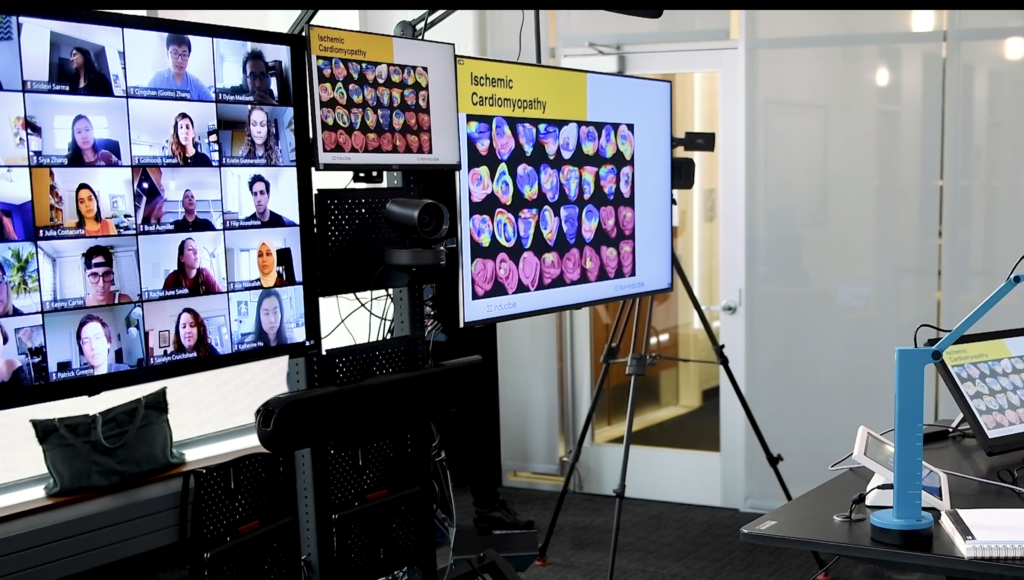
“For students who choose to live on campus in the fall, I’m increasingly thinking campus life will be a combination of a monastery and a minimum-security prison,” higher ed professor Robert Kelchen said. In the coming days and weeks, it will be imperative to compare college reopening plans in terms of a number of factors, including testing protocols, the percentage of courses offered online and the percentage of students invited back to campus. In collaboration with University of Washington professor Carl Bergstrom and Yale School of Public Health professor Gregg Gonsalves, I will be releasing a dashboard. We expect to have some data up in time for next week’s report. According to The Chronicle of Higher Education’s tracker, the percentage of colleges planning for in-person classes has decreased. But what does that exactly mean? “Hybrid” does not mean the same for everyone. These are the questions my dashboard will attempt to answer.
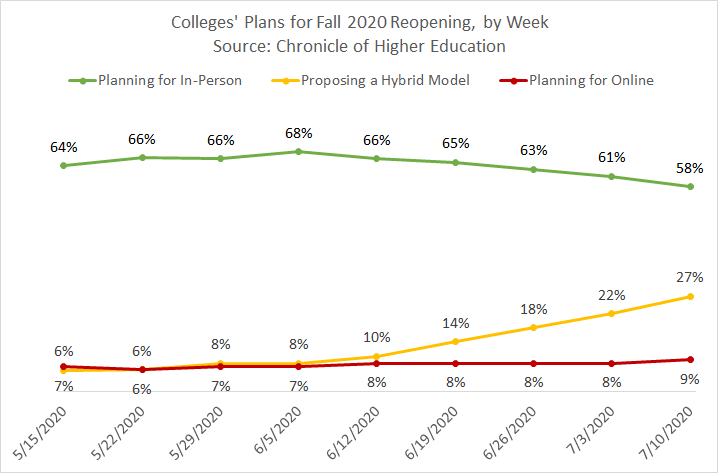
There is no doubt that the most important factor for colleges to reopen (if they choose to do so) is widespread surveillance testing of all community members. Simply reducing classrooms to 42% capacity is not going to cut it. A modeling analysis published by researchers at the Yale School of Public Health found that frequent screening (every 2 or 3 days) of all students with a low-sensitivity, high-specificity test will control outbreaks with manageable isolation dormitory utilization at a justifiable cost. Many colleges only plan to screen students once a week; the University of North Carolina only plans to test symptomatic students (I sure hope you would!) and Colorado College, in line with CDC guidelines, will not test all students upon entry. We need testing that is frequent, fast, cheap and easy (FFCE). Without this necessary step, colleges should reconsider reopening plans. These graphs show the possible numbers of students in isolation dorms compared across various testing frequencies.
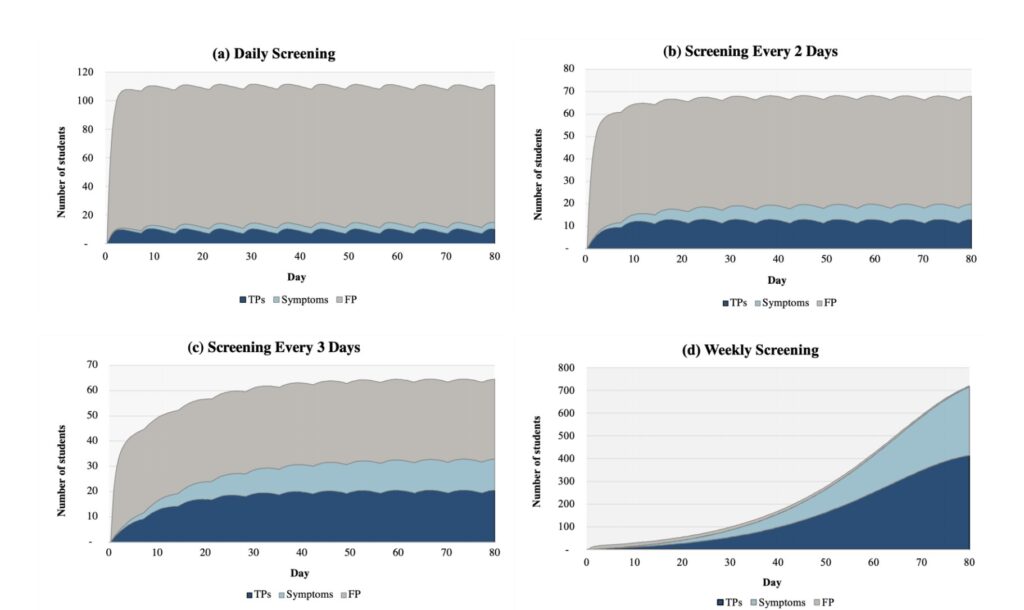
In many ways, colleges’ reopening plans depend on the states in which they are located. Vermont’s guidelines aim to make the state the “safest place in the nation to go to college.” Ohio’s reopening guidelines say to “utilize remote learning opportunities where practicable.” In the coming weeks, we will re-evaluate colleges’ reopening plans in the context of state and financial lines. “We’re exiting the consensual hallucination phase where we thought all things were going back to normal,” NYU Stern School of Business marketing professor Scott Galloway said on CNN.
We have also begun to see more references of “thresholds” — what metrics schools will use to make decisions to switch to online learning during the semester. As the editorial board of the Daily Pennsylvanian argued, “while there are many uncertainties about what the fall will bring, Penn’s criteria for reassessing the hybrid model does not have to be one. And as Franklin and Marshall and Hamilton tell their students to “pack light,” we need more specificity on what it would take to send students home. And in many cases, we have not yet received such clarity.
I am concerned as to how much college reopening plans could detrimentally affect states’ PPE supplies and testing capacity. As my colleague Rachel Cohen reports, Boise State University initially instructed all faculty and students returning to campus to get tested. But earlier this week, citing strained local health systems, the university temporarily narrowed that requirement to individuals who had been in close contact with someone who tested positive for the coronavirus, and to those with symptoms. With people still waiting hours for tests in Arizona and Georgia, is it fair for colleges to procure a huge supply of PPE and tests and possibly hoard these stocks? According to data from the European CDC, tracers trace on average 2-3 contacts per person in a lockdown scenario. Pre-lockdown, this number would be 7 to 20. On a college campus, the number of contacts could be exponentially more.
I would like to briefly address college athletics, which have taken center stage lately. The Ivy League joined many sports leagues in suspending fall conference competition, including the NESCAC and Centennial Conference. “We are running out of time to correct and get things right,” SEC commissioner Greg Sankey told ESPN. It will only be a matter of time before these dominoes fall. In a sign of dire financial troubles, Stanford University and Dartmouth College have announced permanent cuts to sports teams. My map has tracked 438 confirmed cases in college athletics nationwide.
In op-eds and editorials published in student publications across the country, students have cautioned against reopening. “In my mind, I cannot justify the undue risk to hundreds of thousands of lives by opening up because we are too stiff-minded to imagine another way of operating. This situation is awful, but the plan I’ve laid out is the only humane response,” one Southern Methodist University student wrote. One Boston University grad student wrote: “Instead of fighting for the right to teach from anywhere, as teachers have been doing for the past month, this summer would be better spent properly developing courses for online delivery.” Considering the impact on surrounding communities has been at the forefront of students’ concerns. “I also think we need to recognize that our presence could be highly detrimental to the communities around our campuses,” one Pomona student wrote. These student perspectives are vital, as they are the ones who best understand how students live on campuses. “The biggest wild card is obviously student behavior,” I told Bloomberg’s Emma Court and Janet Lorin in an interview. “I do hope students like myself are going to abide by all these rules. But I think I know that’s just not going to happen.” Consider health pledges, for example. On a recent Middlebury Campus survey, 45% of students indicated that they had broken the Honor Code at some point in their careers — an academic pledge not to submit plagiarized work, among other anti-cheating measures. While I do understand that these two types of pledges are different on the surface, and we are in the middle of a global health crisis, these are still young adults being young adults with their risk-taking behaviors. And there is nothing we can change about that.
“This will be one of the worst months in the history of higher education,” Robert Kelchen argues. With case counts increasing, federal support decreasing and jargon such as “initiative,” “fall plan,” “resources” and “working group” filling our minds, we are weeks away from the fall semester. And given worsening national conditions, we need to be making some real decisions here. I’d like to end with this paragraph from Kelchen’s piece in the Chronicle, which I feel best summarizes the current state of higher education.
My plea to college presidents and boards is to announce the inevitable decision to hold most of the fall semester online immediately rather than trying to wait out competitors. This is the right thing to do for everyone in higher education. Students can get a higher-quality education if faculty members have more time to prepare classes. Colleges can devote resources to improving online education and making sure that all remaining in-person classes are as safe as possible. Local communities may see fewer out-of-town students who could spread the virus and tax local health-care systems. Finally, governments and public-health agencies can focus their efforts on safely reopening child-care centers and elementary schools that are essential to an economic recovery and cannot be easily replicated online.
Study abroad and international travel
Forget about it. Fall abroad programs are just not happening, unless you want to go to Kosovo, one of the few countries in Europe currently accepting Americans. Given our lengthy discussion above on the plights of international students, I decided to keep this section short.
The Good Stuff
Let’s roll the clips of the good stuff. In my usual tradition, I feature my favorite stories from the week. Here are my Top 10.
- A horse named Fauci won the first day’s race in Keeneland, Kentucky.
- The retired inventor of N95 masks, Peter Tsai, is back at work, mostly for free, to fight Covid-19.
- Dogs in Colombia are delivering groceries during the pandemic, with baskets in their mouths.
- Japan’s theme parks have banned screaming on roller coasters due to concerns of spreading coronavirus. “Please scream inside your heart,” one theme park official said.
- The New York Times profiled four college graduates entering the workforce from their childhood bedrooms.
- The Consul General of Japan in New York plays the Star Spangled Banner Jimi Hendrix-style on his electric guitar.
- A Muppet version of the songs in Act 1 of the Broadway musical Hamilton.
- A journey of a single burger during the pandemic, from farm to your mouth.
- One look at the possibility of Manhattan’s streets without cars.
- Lockdowns spared millions of animals from becoming roadkill
Conclusion
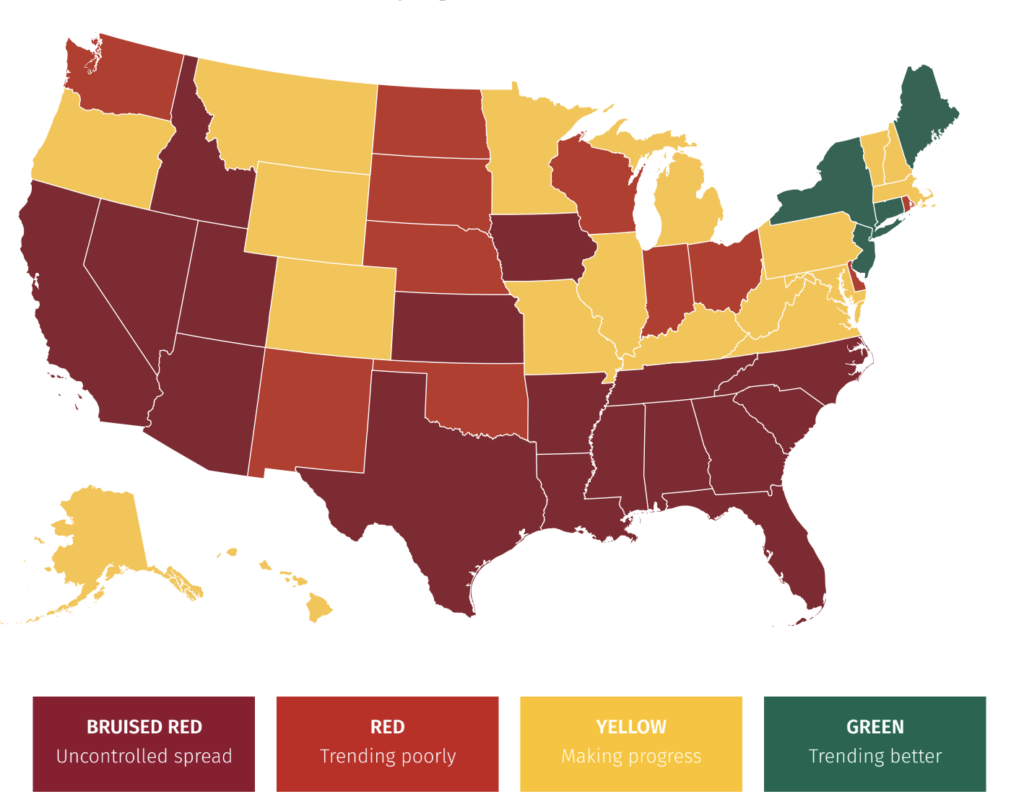
See this map? This is from Covid Exit Strategy, a website run by health experts that analyzes various metrics to determine infection risk levels in all 50 states. Yesterday, analysts added a “bruised red” color for 17 states due to their viral transmission levels being absurdly high. “Unfortunately when a map becomes all “red,” it becomes less useful,” they said. How do we avoid this? Lockdowns are becoming our only possibility. We need the compliance of the general public to ensure our hospitals are not overloaded, though many of them are already. We need more testing. We need the Defense Production Act for more PPE. We need successful contact tracing and for the public to abide by quarantine protocols. The fall is drawing ever closer. In order to have schools, a major driver of the national economy, return, we need to take deliberate actions to slow the spread and control these numbers. Simply rolling back indoor dining to 50% is not enough. The virus is winning, America. After reading a mere 488 articles from various news sources in preparation for this week’s report, this has become abundantly clear to me. This is a national problem and the lives and futures of all of us depend on it.
I’d like to thank all the student journalists with whom I have the pleasure of working. In the next weeks and months ahead, they will become ever more important in chronicling their colleges’ decisions for the fall and beyond. Support their work by reading it.
My best to all for good health.
Like what you see? Don’t like what you see? Want to see more of something? Want to see less of something? Let me know in the comments. And don’t forget to subscribe to the weekly newsletter!
For more instant updates, follow me on Twitter @bhrenton.

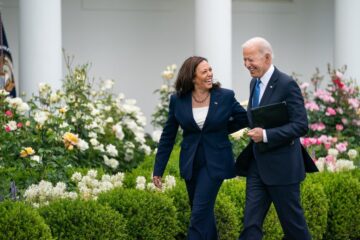

1 Comment
Michael Wasserstein · July 11, 2020 at 7:10 pm
This is fantastic work, Benjy. Thanks again for this impressive writing you are doing!
Comments are closed.